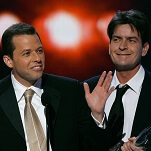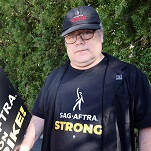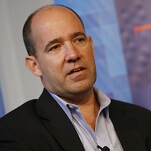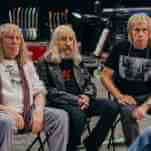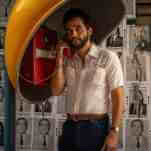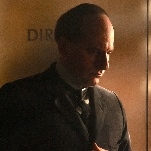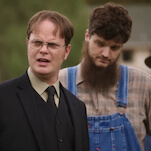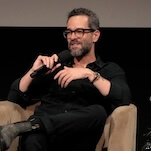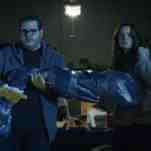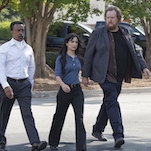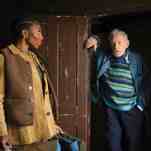I spent last weekend at Movement: Detroit's Electronic Music Festival, a startlingly big 3-day fete of techno and related genre offshoots in a city where the roots for such things grow the deepest. I'd long wanted to go to Detroit ever since happening upon its techno mythology years ago, and it didn't disappoint–either for the disquieting beauty of its dilapidated landmarks or for its status as a place where mythology remains very much alive and well.
The festival itself was an eye-opener. Reports for the biggest day's gathering numbered the crowd around 50,000, and the setting couldn't have been grander: a series of stages and tents dotting Hart Plaza right in the heart of downtown, with a river at the back and skyline buildings (some of them abandoned–certifiable skyscrapers abandoned) rising up all around. The storied conception of Detroit as a sort of Blade Runner dystopia remains true to form, and it's easy still to see how techno–so brooding and futurist in its purest form–developed in a city with a misbegotten monorail, rusty metal-tube walkways connecting buildings, and architectural adventures sketched with a frictive mix of Gothic stone and Modernist glass.
The lineup for the festival toggled between big populist DJs/producers (Moby, DeadMau5, Mark Farina) and others whom those of us who are bookish about techno regard as gods (Carl Craig, Richie Hawtin, Dan Bell, Zip, et al.) Most striking throughout it all was how skewed any conventional sense-of-scale proved for artists who register barely a blip in the U.S. in terms of press coverage. If dance music is so small and niche-oriented here, how do we account for the thousands craning for a look at Carl Craig playing triumphant on the main stage? Or the masses cramming for space to dance to a live set by Alex Smoke?
Detroit has long been an anomaly in terms of electronic music in America, going back to the early-'80s days when local artists invented techno as a homegrown "black music" that would effectively be ignored until later catching fire in Europe. But even then, it wasn't just the fact that the setting was Detroit. Scads of people travel there for the festival every year (this past one marked its ninth year running), and something suggested that the surprisingly robust legions of teenage rave kids on-hand were doing more than just paying historical respects. Certainly the ones wearing fluorescent-green masks with swinging rubber face tendrils were. Either way, the musical highlights were numerous, from Half Hawaii grooving on industrialized syncopation, to Detroit native Kenny Larkin banging in an underground bunker with cement walls, to Berlin DJ Cassy making good on the promise of minimal house-music spun in the afternoon sun.
But then again, the spirit there definitely did owe something to Detroit itself. The festival that runs from the afternoon to midnight gives rise later to all sorts of after-parties, which is where the real highlights hide. Saturday night included a roller-skating party thrown by Moodymann, an enigmatic Detroit character who plays hazy, daze-y house and does things like throw roller-skating parties at a massive old rink on 8 Mile Road with competing teams of dancing skaters and free soul food (ribs, green beans with pork, crusty mac & cheese). The crowd there must have been 80-percent local, and the vibe–so warm and allergic to the even slightest show of pretense–flashed me back to all I've read about the legendary parties in Detroit where techno took root as an idea. Sunday night featured a loft party thrown by original techno pioneer Juan Atkins, who played in an eerily empty townhouse setting in a neighborhood where old Victorian buildings sat abandoned, like something from an episode of Scooby-Doo.
The real heart of the city, at least as I saw it, seemed to beat in two out-of-the-way places the festival didn't touch. First was the old Michigan Central Station, a massive train station not far from downtown that has rotted into what has to be the ultimate monument to the Death Of The Industrial American City. The entire structure is surrounded by barbed wire. All the windows are blasted out. Whole big chunks of stone have fallen off of sconces into shattered piles on the ground. The only sign of life around was two guys shuffling, very much alone, in a forbidding "park" full of weeds.
The other place was both sadder and, to alternately inspiring and devastating degrees, more hopeful. It was the Heidelberg Project, a reclamation enterprise that has turned a few-block area of "the poorest zip code in the U.S." into a dreamy folk-art sanctuary haunted by a quiet humanist roar. Crumbling houses there are painted with big, bright polka dots, and installations in ratty yards were fashioned with old shoes, boats, toys, and the like. One house had somewhere around 100 stuffed animals hanging from its rotting woodwork. Another is being prepped to have its exterior covered entirely with pennies dropped in a bucket.
That was Detroit, where techno takes its place among others as an aspirational and reportorial art.
